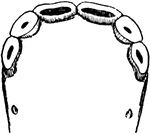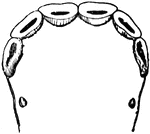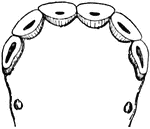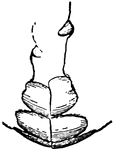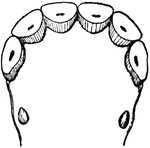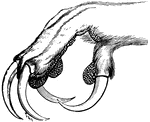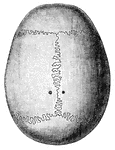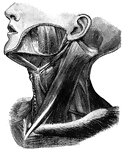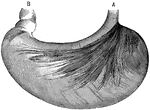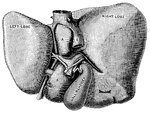
Abdominal
"In human anatomy, certain regions into which the abdomen is arbitrarily divided for the purpose of…
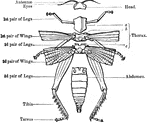
External Anatomy of an Insect Skeleton
"Anatomy of the external skeleton of an insect" — Goodrich, 1859

Mouth and Tongue of a Bee
"The structure of the mouth in insects exhibits very remarkable modifications, and these are of the…

Digestive Apparatus of an Insect
"a, head, antennae, &c; b, pharynx; c, crop; d, gizzard; e, chyle-forming stomach; f, biliary vessels;…
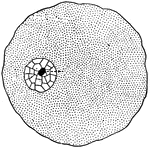
Cell
"In a general what we may describe a cell as a tiny mass of jelly in which floats another still smaller…

Various forms of cells
"A, columnar cells found lining various parts of the intestines (called columnar epthelium);…
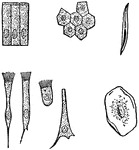
Various kinds of epithelial cells
"A, columnar cells of intestine; B, polyhedral cells of the conjuctiva; C, ciliated conical cells of…

Cross-Section of the Epithelium
"One of the simplest of the tissues in the body is called the epithelium, and its cells are…

White fibrous tissue
"The connective tissue with white fibers sometimes forms a very thin sheet, as in the delicate covering…
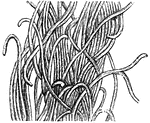
Yellow elastic tissue
"Along with white fibrous tissue, the yellow fibrous tissue... makes the coats of the arteries, and…

Connective Tissue from a Lymphatic Gland
"Consisting of a very fine network of fibrils, around which are cells of various sizes." — Blaisedell,…

Longitudinal section of cartilage
"Showing (1) cartilage with martrix and cells; (2) cartilage with matrix containing cells and white…

Human skeleton
"There are in all two hundred and six seperate bones in the adult skelton. The teeth are not bones,…
Cross-section from a shaft of a long bone
"Little openings (Haversian canals) are seen, and around them are arranged rings of bone with little…
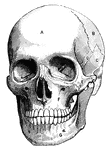
Human skull
"A, frontal bone; B, parietal bone; C, temporal bone; D, sphenoid bone; E, malar bone; F, upper jawbone;…
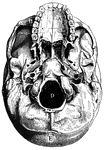
Base of skull
"A, Palate process of upper jawbone; B, zygoma, forming zygomatic arch; C, condyle, for forming articulation…
Spinal column
"The spine or backbone, serves as a support for the whole body. It is made up of a number of…
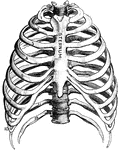
Thorax
"The ribs are long, flat, and curved bones which bend round the chest somewhat like the hoops…

Scapula
"The shoulder-blade is a large, flat, three-sided bone, which is placed on the upper and back…
Humerus
"The humerus, a long, hollow bone, rests against a shallow socket on the shoulder blade. It…
Ulna and Radius
"The ulna, or elbow bone, is the larger of these two bones. It is joined to the humerus by…
Tibia and Fibula
"The leg consists, like the forearm, of two bones. The larger, a strong, three-sided bone with…
Bones of the Foot
"The foot is built in the form of a half-dome or half-arch. This is to afford a broad, strong support…

Elbow Joint
"Showing how the Ends of the Bones are shaped to form the Elbow Joint. The cut ends of a few ligaments…

Powerful Ligament at the Hip Joint
"The bones are fastened together, kept in place, and their movements limited, by tough and strong bands,…

Ligaments of the Foot and Ankle
"The bones are fastened together, kept in place, and their movements limited, by tough and strong bands,…

Broken Radius
"When a bone is broken, blood trickles out between the injured parts, and afterwards gives place to…
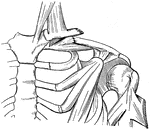
Broken Clavicle
"When a bone is broken, blood trickles out between the incjured parts, and afterwards gives place to…

Broken Tibia
"When a bone is broken, blood trickles out between the injured parts, and afterwards gives place to…
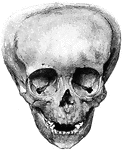
Deformed skull
"Showing how the Bones of the Skull may be artificially deformed by "head-binding." From the photograph…

Striped Muscular Fiber
"A Portion of a Striped Muscular Fiber. Highly magnified. A, fiber separating into disks; B, fibrillae;…
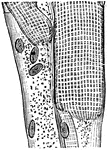
Striped Muscular Fiber
"A Portion of Striped Muscular Fiber, showing Stripes and Nuclei. Highly magnified." — Blaisedell,…
Spindle Cell of Involuntary Muscle
"The involuntary muscles consist of ribbon-shaped bands which surround hollow tubes or cavities…

Superficial Muscles of the Body
"A single muscle rarely or never contracts alone, but always in harmony with a number of other muscles.…

Achillles tendon
"Tendons are white, glistening cords, or straps, which connect the muscles with the bones." —…

Muscles of the Back and Shoulder
"Some of the Larger Muscles on the Back of the Shoulder and the Arm." — Blaisedell, 1904
Thigh Muscles
"Some of the Larger Muscles on the back of the Thigh. Powerful tendons at the hip and on the back of…

Back view of the adult mouth
"The head is represented as having been thrown back, and the tongue drawn forward. A, B…

Principal Organs of the Thorax and Abdomen
"The principal muscles are seen on the left, and superficial veins on the right." — Blaisedell, 1904
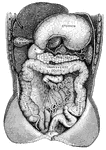
Digestive system
"Showing the Relations of the Stomach, Liver, Intestines, Spleen, and other Organs of the Abdomen. Aduodenum;…
